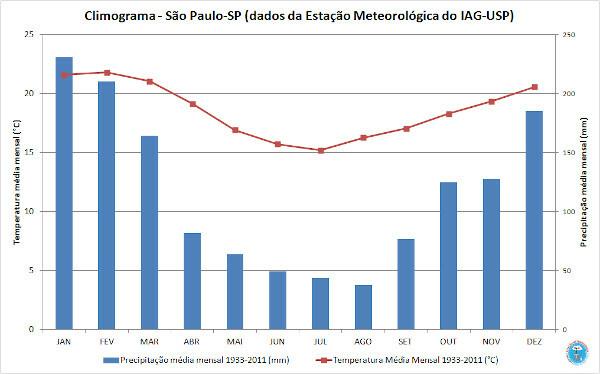O high altitude tropical climate it occurs predominantly in the higher portions of the Southeast region of Brazil, covering areas of São Paulo, Minas Gerais, Rio de Janeiro and Espírito Santo. It is characterized by mild average temperatures, around 18 °C to 22 °C, and rainfall throughout the year, with greater volumes in summer. This climate is strongly influenced by the tropical masses and the Atlantic polar mass, which conditions cold weather in winter, frontal rains and the occurrence of frost.
Read too: Influence of altitude on climate
High altitude tropical climate summary
The high altitude tropical climate occurs in the high areas of the Southeast region of Brazil, predominantly.
It differs from the typical tropical climate because of its milder temperatures.
Average temperatures range between 18 °C and 22 °C, with relatively warmer summers.
Although rains occur throughout the year, they are more abundant in summer. 1,500 mm of precipitation is recorded annually.
Some locations register the formation of frost in winter.
The main air masses acting in the high tropical climate are the continental and Atlantic tropical masses and the Atlantic polar mass.
Do not stop now... There's more after the advertising ;)
High altitude tropical climate characteristics
The high altitude tropical climate is characteristic of situated areas at altitude equal to or greater than 800 meters, occurring in the latitudinal ranges corresponding to the intertropical zone of the planet. The main aspect that sets it apart from tropical weather typical is the temperature, which, due to the geographic elevation, is milder than in the lowered areas.
Tropical altitude climate temperature
Temperatures in the high-altitude tropical climate are considerably milder than in the typical tropical climate, as we have seen. At averages are around 22 °Ç, and the thermal range annual, that is, the temperature variation during the year, is between 7 °C and 9 °C.
O summer it is the hottest season of the year, but the highs are between 25 °C and 28 °C, commonly below 30 °C. Under the action of the cold masses, the Winter it is the season that registers the lowest temperatures, which can vary between 15 °C and 18 °C.
Precipitation and humidity in high altitude tropical climate
The moisture input of the high altitude tropical climate is influenced by the performance of the wetter air masses, such as mTa and mPa, and also by the intense evapotranspiration which takes place in the hottest months of the year.
At rains occur during all months of the year, but they are more abundant in the period from October to March, comprising much of the spring and summer months. The rainfall volume decreases considerably in winter, especially between June and August. Annually, an average of 1,500 mm of rain is recorded.
In winter, some locations register the frost occurrence, phenomenon characterized by the formation of a thin layer of ice on the foliage.
High altitude tropical climate vegetation

Many high-altitude tropical climate locations are covered by forest formations such as the tropical florests, like the Atlantic forest in the Southeast region and part of southern Brazil. In this region, another typical formation that can be found mainly in the central portion of the state of Paraná is the Araucaria Forest.
Open fields, with medium and small vegetation, such as shrub species, small trees and grasses, they are also formations that can be observed in areas of high altitude and climate with alternately wet season and dry.
Read too: Brazil's morphoclimatic domains — areas defined based on their landscape composition
Air masses that act in the high tropical climate
As with other types of weather, the high altitude tropical climate is influenced by the action of different air masses. These large atmospheric bodies carry with them the characteristics of temperature and humidity of the place where they are form (region of origin) and, as they move, transfer these properties to the areas that cross.
Taking this into account, we have the performance of the following air masses in high altitude tropical climate:
Atlantic Tropical Mass (mTa): this air mass originates in the tropical zone, on the surface of the waters of the Atlantic Ocean. As a result, it has high temperatures and high moisture content. mTa is one of the main causes of rainfall in areas with high tropical climates and its action is more intense in summer.
Continental Tropical Mass (mTc): it also originates in the intertropical zone, but, unlike mTa, it forms over the continent. It is a hot mass with low humidity. It operates throughout the year, mainly in the Midwest, Southeast and South regions of Brazil, and its passage conditions the occurrence of high temperatures and dry weather.
Atlantic Polar Mass (mPa): unlike the previous ones, the polar mass is a cold and humid air mass that forms over the ocean in the polar zone. Like mTa, it brings rain to areas where the high-altitude tropical climate occurs, which is mainly due to the formation of so-called cold fronts. In addition, mPa is responsible for the drop in temperatures and acts with greater strength in the months corresponding to winter.
High altitude tropical climate in Brazil
The high altitude tropical climate is exclusive to some portions of the regions Southeast and South of Brazil, more precisely those located above 1,000 meters of altitude. This climate covers the following areas:
eastern and southeastern part of the state of São Paulo;
central, southeast and a small portion of the northwest of Minas Gerais;
mountain region of Rio de Janeiro and part of Holy Spirit;
narrow strip in the northern portion of the southern region, predominantly in the state of Paraná.
→ Video lesson on climates in Brazil
Solved Executions on High-Altitude Tropical Climate
question 1
Pay close attention to the climogram below. The bars in blue indicate the volume of rainfall recorded for each month, while the red line represents the variation in temperature.
Source: Meteorological Station of IAG/USP – Technical Section of Meteorological Services. Available in:. Access on 1st Oct. 2021.

Identify which climate type is represented above:
a) Subtropical climate.
b) Arid tropical climate.
c) Equatorial climate.
d) High altitude tropical climate.
e) Coastal climate.
Resolution: Alternative D. The weather chart above represents the climate of the Sao Paulo City (SP). The rainfall graph indicates the concentration of rainfall in the months corresponding to the summer, especially in December and January. Winter is the driest season, with the lowest rainfall between June and August. Temperatures in summer are high, but are around 22 °C, while in winter the lowest recorded is 15 °C. These features are representative of the high tropical climate.
question 2
The high altitude tropical climate differs from the typical tropical climate by its milder temperatures. It occurs in the plateaus and mountains of the Southeast region of Brazil, and can be observed in other places in the national territory. All characteristics listed below are indicative of this climate, except:
a) relatively hot summers and cold winters, with the occurrence of frost.
b) abundant and well-distributed rains throughout the year.
c) advance of cold fronts that give rise to frontal rains.
d) average temperatures around 18 °C.
d) action of polar and tropical masses.
Resolution: Alternative B. In the high tropical climate, rains occur throughout the year, but the greatest volumes are concentrated in the summer months. This means they are not well distributed. This alternative actually reflects a characteristic of the subtropical climate.
By Paloma Guitarrara
geography teacher



